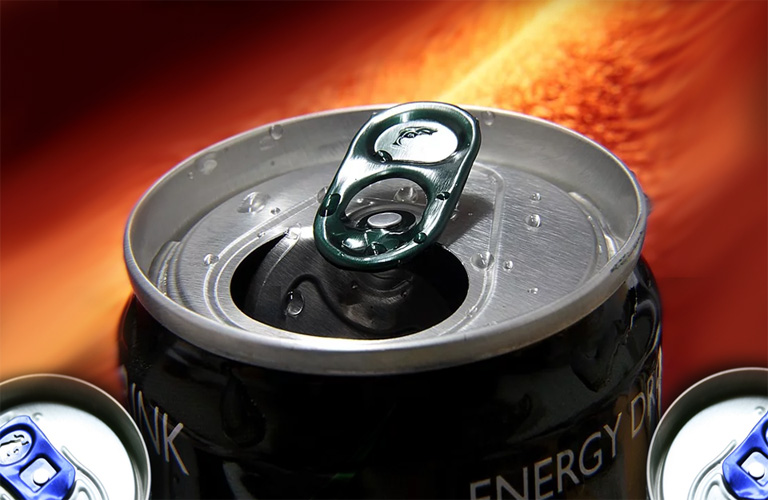Consuming energy drinks raises important safety concerns
Energy Drinks & Potential Health Risks
A growing body of scientific evidence shows that energy drinks can have serious health effects, particularly in children, teenagers, and young adults. Due to high content of di- or monosaccharides and biologically active compounds (mainly caffeine), their regular intake may involve addictions and potential health risks, including diabetes.
Energy drinks are widely promoted as products that increase energy and enhance mental alertness and physical performance. Next to multivitamins, energy drinks are the most popular dietary supplement consumed by American teens and young adults. Men between the ages of 18 and 34 years consume the most energy drinks, and almost one-third of teens between 12 and 17 years drink them regularly.
There are two kinds of energy drink products. One is sold in containers similar in size to those of ordinary soft drinks, such as a 16-oz. bottle. The other kind, called “energy shots,” is sold in small containers holding 2 to 2½ oz. of concentrated liquid. Caffeine is a major ingredient in both types of energy drink products—at levels of 70 to 240 mg in a 16-oz. drink and 113 to 200 mg in an energy shot. (For comparison, a 12-oz. can of cola contains about 35 mg of caffeine, and an 8-oz. cup of coffee contains about 100 mg.) Energy drinks also may contain other ingredients such as guarana (another source of caffeine sometimes called Brazilian cocoa), sugars, taurine, ginseng, B vitamins, glucuronolactone, yohimbe, carnitine, and bitter orange.
Excessive consumption of caffeine may acutely cause caffeine intoxication, resulting in tachycardia, vomiting, cardiac arrhythmias, seizures, and death. The effects of chronic high-dose caffeine intake in children and adolescents are unknown. Caffeine may raise blood pressure, disrupt adolescent sleep patterns, exacerbate psychiatric disease, cause physiologic dependence, and increase the risk of subsequent addiction.
The amounts of caffeine in energy drinks vary widely, and the actual caffeine content may not be identified easily. Some energy drinks are marketed as beverages and others as dietary supplements. There’s no requirement to declare the amount of caffeine on the label of either type of product.

Excessive energy drink consumption may disrupt teens’ sleep patterns and
may be associated with increased risk-taking behavior.
What You Should Know
Although consumption of energy drinks is usually not recommended by the manufacturers to the children under the age of 16, due to its popularity and unrestricted availability on market energy drinks are easily accessible to younger children. Low awareness of the potential health risks involved with such beverages in society together with unrestricted distribution and advertising requires undertaking general information campaign concerning energy drinks. Read more about their contribution to current health concerns for children and adolescents...Coingestion of caffeine and ethanol has been associated with increased risk-taking behaviors, harm to adolescent users, impaired driving, and increased use of other illicit substances. Read more about toxicity of energy drinks...
Guarana, commonly included in energy drinks, contains caffeine. Therefore, the addition of guarana increases the drink’s total caffeine content.
Between 2007 and 2011, the number of energy drink-related visits to emergency departments doubled. In 2011, 1 in 10 of these visits resulted in hospitalization.
About 25 percent of college students consume alcohol with energy drinks, and they binge-drink significantly more often than students who don’t mix them. The CDC reports that drinkers aged 15 to 23 who mix alcohol with energy drinks are four times more likely to binge drink at high intensity (i.e., consume six or more drinks per binge episode) than drinkers who do not mix alcohol with energy drinks.
Drinkers who mix alcohol with energy drinks are more likely than drinkers who do not mix alcohol with energy drinks to report unwanted or unprotected sex, driving drunk or riding with a driver who was intoxicated, or sustaining alcohol-related injuries.
People who combine caffeinated drinks with alcohol may not be able to tell how intoxicated they are; they may feel less intoxicated than they would if they had not consumed caffeine, but their motor coordination and reaction time may be just as impaired.
In 2011, 42 percent of all energy drink-related emergency department visits involved combining these beverages with alcohol or drugs (such as marijuana or over-the-counter or prescription medicines).
Source: National Center for Complementary and Integrative Health (NCCIH) from the National Institutes of Health.





